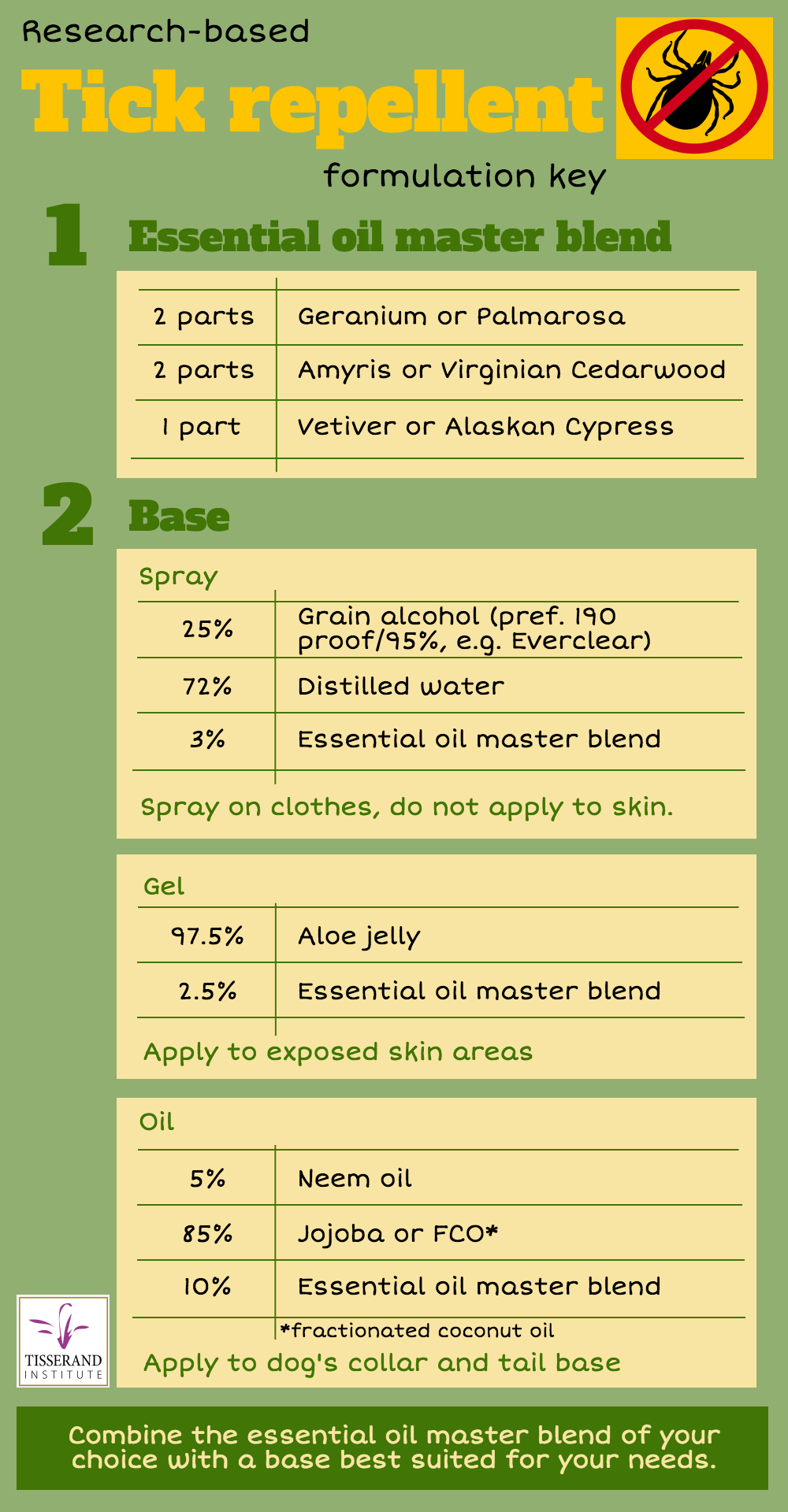The Tisserand Institute tick repellent!
Here is a formulation key for three different product types you can use to ward off unwanted ticks.
Start with making the master blend. Choose one from each row of essential oils eg. Palmarosa, Amyris and Alaskan Cypress (Chamaecyparis nootkatensis). Then depending on how you want to use the repellent, chose one of the three bases to mix the complete blend in.
Spray is most suitable for application to shoes, clothing, backpacks etc., and is safe even for children over the age of 2. We have seen many formulations online containing vodka, witch hazel distillate, cider vinegar or hydrosols. Note that none of these will effectively solubilize essential oils! Also, the water must be distilled, and the formulation should be used within a few weeks.
If not wearing long pants and long sleeves – or if you want to avoid alcohol – use the gel and apply to exposed skin areas. Please note that “aloe jelly” is not the same thing as “aloe gel”. Aloe gel is 99% water, and will not solubilize essential oils. Aloe jelly also contains added thickeners, and you can easily mix in essential oils.
For dogs, use a drop or two of the oil formulation on the collar and tail base. Please do not use for cats. There’s no reason why you couldn’t use just the essential oils for shoes, pant legs, hats etc.
The formulation is based on a thorough revision of published research. Geranium oil has been widely used. For example, Gretchen Morgan Stern, who owns an aromatherapy store in a heavily infested area, told us: “for years my customers have told me that Geranium oil works best.” Robert Tisserand searched for effective options that work on more than one species of tick, and we also wanted a formulation that combines oils of varied volatility for a longer-lasting effect.
Cosmetic chemist Ginger L. Moore helped us formulate most suitable and safe bases, and the whole formulation was checked with Sue Pace, ER nurse and the author of our Tick Talk blogpost.
Hopefully all the hard work translates into an efficient and useful formulation. Let us know if you used it and how it worked!


Thank you so much for this recipe!!! You are appreciated 😉
Hi – look like a great recipe!
Is there a particular type of geranium oil that is best to use as a tick repellent, or are they all as effective as one another? e.g. pelargoneum graveolens vs pelargonium roseum vs geranium bourbon?
Appreciate your advice on this.
Thanks.
They are all equally effective.
Hi Robert and Hana, I’ve two questions please:
In the spray recipe, the master blend content is 3% and in the oil recipe it is 10%, is there any reason for this?
Would atlas Cedarwood work instead of virginian?
Many thanks. Kind regards
Hi Ellen, the formulations are from Sue Pace, so she may also comment here, but the difference is basically because these are two different types of application, and because 10% of EO would not be soluble in that spray formulation. The evidence suggests that Cedarwood Atlas would not be as effective as Virginian.
Hi , Thank you so much for the reply and information.
Does this work against mosquitoes as well?
Not really – it’s specifically formulated for ticks. Here’s a mosquito repellent formulation https://tisserandinstitute.org/learn-more/mosquito-repellents/
Could perfumers alcohol work instead of everclear in the spray?